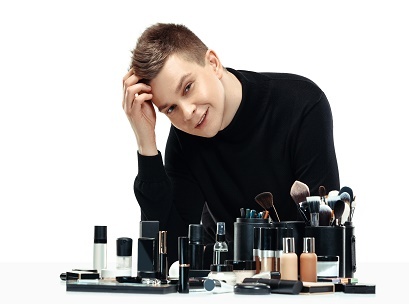
While men are more style-savvy today than in previous times and are increasingly adopting a skincare regime, are they ready to start wearing eyeliner and bronzer? Cosmetics companies are looking for untapped market segments to grow their businesses in a highly competitive environment.
However, product diversification is the most risky of all growth strategies. So, while cosmetics brands are busily formulating and packaging male cosmetics, is society ready to accept men in mascara?
A history of the painted man
Men have been wearing make up for millennia. It wasn’t until the mid-1800s that makeup became associated specifically with females and by the 20th century, makeup was definitely considered to be a female-only product.
But as far back as 10,000 BC, Egyptian men cleaned and softened their skin using essential oils and from 4000 BC, they wore heavy kohl green and black eyeliner in an attempt to protect their eyes from flies, infection and the sun’s rays. In ancient Rome, men applied red pigment to their cheeks and in Elizabethan England, men enthusiastically covered their faces with white power (which often contained deadly lead). Members of the 18th century French male aristocracy joined their female counterparts in painting their faces, applying beauty spots and indulging in wigs.
But then society changed. There was a stigma attached to wearing makeup and “men were men”.
Big brands see big opportunities
While male cosmetics may be considered niche, dominated with smaller bespoke brands like Bulk Homme, Mënaji and BM Cosmetics, global houses like Chanel are now moving to capitalise on this segment. This suggests male makeup may soon become mainstream.
Tom Ford recently launched into male cosmetics, offering a concealer, brow definer, bronzing gel and a purifying mud mask. Yves Saint Laurent created concealers for men and Clinique has expanded from male grooming and moisturisers to facial bronzers for men.
The global male grooming product market is estimated to grow 5.44 per cent from 2019 to 2027 and is expected to reach US$223 billion ($321 billion) by 2027.
The rise of influencers
Market growth is primarily due to the growing middle-class population with rising disposable incomes, growing media exposures and the increasing willingness of men to adopt a grooming regimen. Rising influence and promotional activities featuring male icons have also been greatly instrumental in providing the necessary push for the change.
In 2016, CoverGirl named James Charles as its first male ambassador. With almost 14 million YouTube followers, the makeup and beauty vlogger regularly pulls thousands of loyal fans to shopping centre appearances, with many waiting hours just for a glimpse.
Similarly, the huge popularity of television programs such as Queer Eye and Ru Paul’s Drag Race as well as K-Pop and male influencers reflect the broader changes that are taking place in many societies around the globe which now consider male grooming and makeup as natural extensions of self-expression.
Attitudinal and societal changes are also being facilitated through legislation; for example the move in many jurisdictions to recognise gender neutrality by introducing gender-neutral birth certificates and providing more support for transgender children in schools.
A risky exercise
Faced with increased competition, the proliferation of brands, products and multiple emerging trends, iconic brands like Revlon and Coty (Max Factor, CoverGirl) have struggled. As such, cosmetics companies are constantly looking for opportunities to grow. Although the cosmetics industry is in its maturity stage in most developed markets, it exhibits a high degree of innovation, and male cosmetics is one example.
However, Igor Ansoff’s 1960 Growth Matrix illustrates how risky this move is for mainstream cosmetics houses to shift into new markets with new products. The easiest way to grow a business is to encourage more of your existing customers to buy more of your existing products. This is normally attained by increasing promotional spending or advertising. A second option is to develop new products for your existing customers. For example, Olay’s Regenerist range offers a premium alternative to their existing market of customers. Naturally, there may be risk in launching a new product into a market that is already being serviced and there may be a level of cannibalisation.
Alternatively, businesses may choose to offer existing products to new markets, often through international expansion into emerging markets like India or China. Again, risks are higher when entering a new market with political, cultural, economic and language differences.
Yet the risk of failure is at its highest when attempting to develop new products for a new market segment, such as cosmetics for men.
Is society ready?
It appears that the answer is yes. This is particularly so in Australia where we have recently legalised same-sex marriage and where topics that were once considered taboo (for example, the male pill) are now much more openly discussed and considered in the broader community.
Gary Mortimer is an associate professor in marketing and international business at Queensland University of Technology. Dr Louise Grimmer is a lecturer in marketing at the University of Tasmania.





